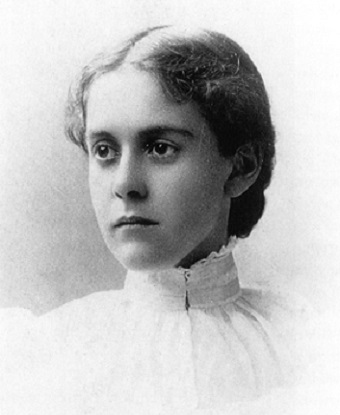Last updated: April 12, 2021
Person
Dr. Alice Hamilton

Schlesinger Library, https://cfmedicine.nlm.nih.gov/gallery/photo_137_7.html.
Dr. Alice Hamilton saved countless workers’ lives as a pioneer in industrial health and safety. Beginning in the 1890s, she treated working-class immigrant patients at Hull House in Chicago.[1] She learned about how diseases, toxic chemicals, and workplace injuries hurt poorer people the most. Dr. Hamilton fought to end these disparities. She investigated companies' safety records and pushed for stronger worker protections. She also promoted the peace movement and women’s rights. In 1919, Dr. Hamilton became the first woman on the faculty at Harvard University.
Alice Hamilton was born in 1869 and grew up in Fort Wayne, Indiana. She studied medicine at the University of Michigan, graduating in 1893. She completed further training in bacteriology (the study of bacteria) and pathology (the study of diseases).
In 1897, Dr. Hamilton took a job at Northwestern University. She also joined Hull House, the settlement house on Chicago’s West Side. Founded by social reformers Jane Addams and Ellen Gates Starr, Hull House was the most famous of the American “settlement houses.” Progressive reformers set up these institutions in poor urban areas. Middle-class settlement workers and their low-income neighbors lived and worked closely together. Reformers hoped they would not only solve pressing social problems, but also forge bonds across social classes.
Hull House served communities of working-class immigrants. Many of them endured dangerous and toxic conditions at their jobs and in their homes. Diseases like typhus and typhoid fever spread quickly in crowded tenements. Poorer neighborhoods lacked adequate sanitation services from the city. Governments did not require businesses to protect employee health and safety. Workers died in industrial accidents caused by heavy machinery and dangerous conditions. Some factories released poisonous chemicals like lead and mercury.
At Hull House, Dr. Hamilton saw this toll up close. Galvanized, she started publishing studies on what was then called “industrial medicine.” In 1908, the state of Illinois appointed her to its new Occupational Diseases Commission. This was the first government body to investigate employee health and safety. Dr. Hamilton conducted a study of industrial toxins that led to the passage of an influential worker protection law in Illinois. She went on to work for the Labor Department conducting similar studies in other states. Alongside Jane Addams, Dr. Hamilton also continued to work for women's rights, including suffrage, and the international peace movement.
In 1919, Harvard hired Dr. Hamilton to join its new Department of Industrial Medicine. She became the first woman on the faculty there. The university had not planned on breaking this glass ceiling. But industrial medicine was a female-dominated field. Many male doctors saw it as linked to reform causes associated with women, and avoided it. "I was really about the only candidate available," Hamilton wrote later.
Dr. Alice Hamilton laid the foundation for health and safety protections we take for granted today. A drive to protect vulnerable people and hold industry accountable fueled her work as a public health pioneer.
Notes
[1] Hull House was designated a U.S. National Historic Landmark on June 23, 1965. It is currently a museum. More information about the site is available at https://www.hullhousemuseum.org.
Bibliography
"Alice Hamilton and the Development of Occupational Medicine." National Historical Chemical Landmarks Program. American Chemical Society. 2002. https://www.acs.org/content/acs/en/education/whatischemistry/landmarks/alicehamilton.html.
"Dr. Alice Hamilton." Changing the Face of Medicine. U.S. National Library of Medicine. Last modified June 3, 2015. https://cfmedicine.nlm.nih.gov/physicians/biography_137.html.
Gore, Karenna. "The Remarkable Life of the First Woman on the Harvard Faculty." New York Times, Aug. 29, 2019. https://www.nytimes.com/2019/08/29/opinion/alice-hamilton-harvard.html.
Hamilton, Alice. Exploring the Dangerous Trades: The Autobiography of Alice Hamilton, M.D. 1943. https://archive.org/details/in.ernet.dli.2015.75264/page/n15/mode/2up.
Article by Ella Wagner, Cultural Resources Office of Interpretation and Education.
